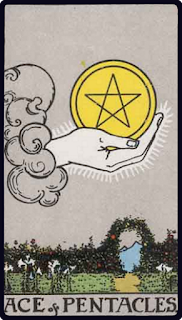
Representing beginnings; the Ace of Pentacles is associated with opportunity, new beginnings and change. It can also represent the arrival of something new that will come under your responsibility.
In the upright state the Ace of Pentacles pertains to novelty, that which has not been seen before or which is entirely new to us. The emphasis here is placed on opportunity and potential, a journey of discovery, a blank canvas, or an acquisition. This card in this orientation is generally favourable, in this state it portends something of benefit.
In the inverted state the Ace of Pentacles as with the other Aces pertains to renewal; here again opportunity and potential frame the material wealth we have already acquired. This could be an opportunity to sell something we have held onto for some time, or an opportunity to transform something we already own into something else, for example you may find a use for a book that you had long abandoned or suddenly have need of clothes you have not worn for some time.
Alternatively, the inverted Ace of Pentacles could portend a new commitment that will potentially be of loss to us in the long run, but an obligation nonetheless, this could be a new bill or financial obligation, or the responsibility for maintaining something physical on behalf of ourselves or another with no obvious reward for this responsibility.
In the Rider-Waite deck the theme of creation and transformation is depicted with the scene of a garden, possibly Eden, above which the hand of God emerges from a cloud holding a golden coin emblazoned with a pentacle. This represents God’s gift of creation, by creating the material realm and granting humanity the ability to influence it. This further underlines the belief that the act of true creation is divine and beyond human capacity, whilst this might at first be disheartening, take comfort in the realisation that true destruction is also divine and beyond human capacity – humans can be disruptive, but we can’t truly be destructive.
The story of creation is further referenced, in the original, or faithful reproductions of the Rider-Waite deck there are 6 white flowers to the left represent the first 6 days of creation according to the Book of Genesis, with a seventh white flower to the right representing the Sabbath, or Seventh Day upon which God rested.
In self-reflection the Ace of Pentacles serves as a prompt to consider recent acquisitions or recent changes in our environment. What new possessions have we acquired, what new obligations or expectations have we taken on, or what changes have occurred recently either in ourselves or in the situation that we find ourselves in. This also extends to knowledge and experiences as well as physical locations such as a new home, new office, new school or classroom etc.
Ask yourself “What is different today, what has changed and when did that happen?” your frame of reference should extend beyond the point where you became aware of the possible impact it has had on you, so for this reason you may have to go back further than you might first think. The easiest way to determine how far this frame of reference needs to extend is to ask yourself “When did I not feel like this?” and go back as far as you need to go.
Changes can often occur gradually, only causing concern when we finally notice the magnitude of that change. It can be very useful here to start the process of documentation as this will make it easier in future to be able to find the source of change in hindsight. Some people keep journals or blogs, others take photos, or videos which they may or may not share publicly, the key objective is consistency. Whatever the means you use to document your state, it must remain consistent so that you can return to it in time and use it as a basis for reflection to determine the magnitude of change or the extent to which things have remained constant. The easiest way to maintain consistency is to adopt a template or format that you can use when documenting. For example, if you use a journal then each entry should note the things you want to track such as your mood, write how you felt that day in addition to what happened. The objective is to gather data that can construct a timeline illustrating change over time.

No comments:
Post a Comment
All comments are moderated before they are published. If you want your comment to remain private please state that clearly.